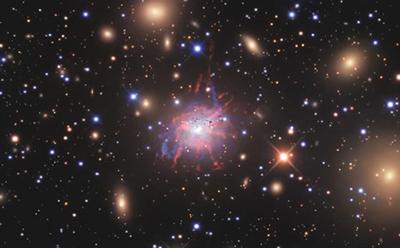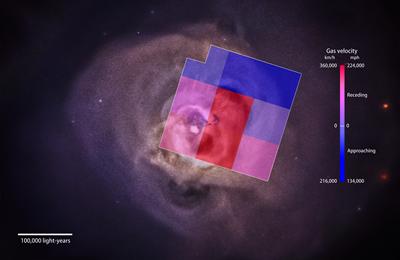Dead satellite shows new horizon for X-ray astronomy

Measurements of unprecedented detail returned by Japan’s Hitomi X-ray satellite have discovered that the gas in the Perseus cluster of galaxies is much less turbulent than expected.
Most of the gas in the Universe lies between galaxies so understanding how turbulence mixes this gas allows astronomers to explore how galaxies form and evolve.
Hitomi suffered a fatal anomaly in March, one month after launch. But before its untimely demise, Hitomi was able to peer into the Perseus cluster of galaxies, a collection of thousands of galaxies bound together by gravity. Located about 240 million light-years away, the Perseus galaxy cluster contains a vast amount of extremely hot gas. At temperatures averaging 90 million degrees Fahrenheit (50 million degrees Celsius), the gas glows brightly in X-rays.
Prior to Hitomi’s launch, astronomers lacked the capability to measure the detailed dynamics of this gas, particularly its relationship to bubbles of gas expelled by an active supermassive black hole in the cluster’s core galaxy, NGC 1275.
Earlier studies explored the pressure of gas between Perseus’s galaxies. Hitomi looked instead at turbulence within the gas, because those motions can affect measurements of a cluster's mass and estimates of how galaxies come together.
Researchers discovered that superheated gas at the cluster’s heart flows much more calmly than expected, given the amount of astrophysical action in the region. Hitomi’s X-ray spectrometer revealed gas moving at 164 kilometres per second (365,000 miles an hour) – enormous by human standards but surprisingly modest on cosmic scales. The results, published in the journal Nature, indicate that turbulence is responsible for just four per cent of the energy stored in the gas as heat.
Dr Poshak Gandhi, Associate Professor and STFC Ernest Rutherford Fellow in the University of Southampton’s Astronomy Group, was one of over 200 astronomers from over 60 contributing institutions in Japan, the US, Canada and Europe involved in the major international collaboration.
He said: “Hitomi has revealed the tremendous scientific potential of next generation X-ray astronomy. This is only the first peek into a universe of discoveries. For instance, Hitomi was supposed to observe all kinds of growing black holes in order to learn how these ultra-dense objects grow and evolve. Unfortunately, we could not gather data on any isolated black holes before Hitomi's anomaly. Many questions will remain unanswered for now.”

“Of course we had a programme planned to look at more clusters, and we would have carried on for the next few years had it only lived,” says Andrew Fabian, an astronomer at the University of Cambridge and a member of the Hitomi team who led the analysis. “It feels like the door has been briefly opened, showing us a new and exciting landscape — and it’s been slammed in our face again.”
Led by the Japan Aerospace Exploration Agency (JAXA), Hitomi launched on 17 February and made the Perseus observations on 25 February and 4 March, weeks before suffering a mission-ending spacecraft anomaly on 26 March.
Hitomi’s revolutionary Soft X-ray Spectrometer (SXS) provided 30 times the detail of the best previous observation. Hitomi’s SXS could measure the turbulence in the cluster to a precision of 10 kilometres/second, whereas previous observations could only constrain the speed to be lower than 500 kilometres/second.
The new Hitomi measurements aren’t quite as precise as they could have been, because the team had not gone through all its calibrations before losing the satellite. The data were gathered through one of the main shutters still partly shut and blocked by a protective valve, which underlines the true potential that Hitomi could have demonstrated once fully operational. However, the Perseus work is likely to stand as Hitomi’s primary scientific legacy.
Dr Gandhi said: “It is time to turn our attention to the future. Toward this end, in February of next year, we will be organising a UK-wide meeting at the Royal Astronomical Society in London to discuss future strategies for X-ray astronomy. We hope to build upon the momentum that Hitomi has provided. The UK has been a pioneer in this field for many years, and it can play an enhanced leadership role if there is the community-wide will to do so.”
The next mission that will be capable of fully following up the Hitomi programme is the European Space Agency’s ATHENA, an X-ray observatory scheduled for launch in 2028. ATHENA will have 100 times more collecting area and 100 times more pixels than Hitomi. Among the key scientific objectives of ATHENA are to investigate the evolution of clusters of galaxies including their interplay with energy injection from supermassive black holes.